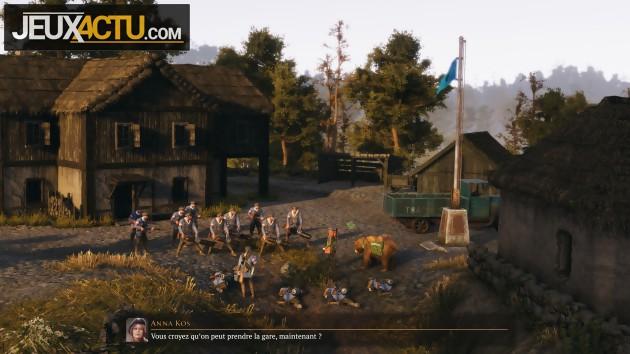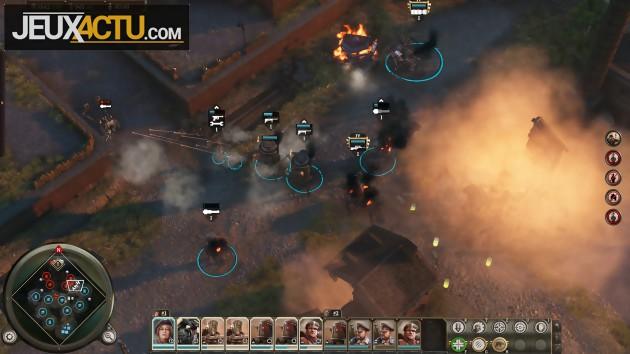The 1920+ universe was created a few years ago by Polish illustrator Jakub Różalski, and was adapted into a board game (Scythe) in 2016. The next step could only be a video game adaptation, and it is now done thanks to Iron Harvest. This real-time strategy game takes place in this fictional (or more exactly uchronic) and steampunk (or more exactly dieselpunk) universe, which introduces mechas in a world clearly inspired by the First World War. Moreover, the single player campaign of Iron Harvest does not hesitate to evoke figures such as Joan of Arc or Nikola Tesla, just to anchor this particular universe more effectively in the minds of the players. The American-Austro-Serbian inventor is also at the origin of automachines, which replace tanks in this spatio-temporal line. These are gigantic mechs controlled by humans placed inside. The forces in conflict take the name of Saxony, Rusviet and Polonia, and correspond respectively to Germany, the Soviet Union and Poland. The campaign is therefore divided into three acts, which makes it possible to play alternately with each faction and therefore to consider the events through different points of view.
IRON AND OIL ARE THE TWO TEARS OF WAR
The missions are relatively classic (defend a position, establish a camp, raze an enemy base...) and, it must be admitted, some of them drag on a little too long. Nothing catastrophic in all this, but the developers could have spared us some last-minute enemy landings, sometimes more off-putting than invigorating. Fortunately, the narrative cutscenes that are interspersed between each mission are a nice carrot. And above all, we enjoy controlling the heroes of each faction. Not only are these special units far more powerful than the others and have specific abilities, but some of them are also accompanied by a very friendly pet. The young Anna Kos defends Polonia with the help of her bear, the Saxon Gunter von Duisburg teams up with two wolves, and the rusviette Olga Morozova fights with a tiger.
If the universe of Iron Harvest is original, its mechanics are extremely classic.
If the universe of Iron Harvest is original, its mechanics are extremely classic. We find a system of resources similar to that of Company of Heroes, with strategic positions which, once captured, provide a continuous flow of iron or oil. As for the bases to be built, they prove to be viable very quickly, since a simple trio headquarters/barracks/workshop is enough to constitute powerful infantry and mecha troops. Do not believe that the game is simplistic. It actually requires a good dose of micromanagement, since our units can pick up medikits, one-time resource packs, or weapons that defeated enemies have dropped in the field, which allows for example to transform a unit from grenadier infantry. It is also necessary to take care "by hand" of the cannons and other artillery pieces that the infantry can handle, to recover iron and oil from the wreckage of the mechs, and to ensure that our units with the most experience survive as long as possible, because the most advanced have more hit points and abilities than the others.
Positioning is also an important component of the gameplay, since the automachines are less armored in the rear, while the infantry gains in defense when placed behind elements of cover (sandbags and other walls). Pedestrian units can also take shelter inside houses, but beware, this solution is not necessarily miraculous. Indeed, the decorations have the good taste to be destructible, and it is enough that a mecha passes by there so that our improvised shelter turns into a simple pile of stones. The power that we feel when directing these robotic machines, which in addition have damn class, is clearly one of the strong points of the game. But it is also a weakness, since we therefore tend to neglect the infantry units, whose role ultimately seems secondary.
IS THE HARVEST GOOD?
This is not the only fault of the game, which also sins with regard to artificial intelligence (especially in skirmishes), the pathfinding of units (pedestrian as robotic) and the number of maps and modes available. It is indeed missing some elements promised during the Kickstarter campaign, starting with the coop mode. These various shortcomings darken the final picture which, without that, would have been particularly brilliant. Because the desire to do well on the part of the developers is constantly felt. Thus, many small options make life easier for the player, such as the possibility of moving units backwards, or the retreat to base function, which increases movement speed and resistance to damage. And outside of the gameplay, we can also mention the options to display the framerate or the ping only when the value of the latter becomes too low. A very good idea, which we would like to see generalized to all games.

It is indeed missing some elements promised during the Kickstarter campaign, starting with the coop mode. These various shortcomings darken the final picture which, without that, would have been particularly brilliant.
In general, the fluidity is also rather good, and the graphics are of very good quality for a real-time strategy game. Obviously, if we compare them to those of a TPS AAA, the cinematic scenes may seem a bit too limited or rigid. But for an RTS, which has to deal with models made to be observed from afar, there's really nothing to complain about. The game even allows itself a nice little tilt-shift effect on occasion. The final assessment is therefore generally positive, and we sincerely hope that the future patches already mentioned by the developers will improve things further.


























